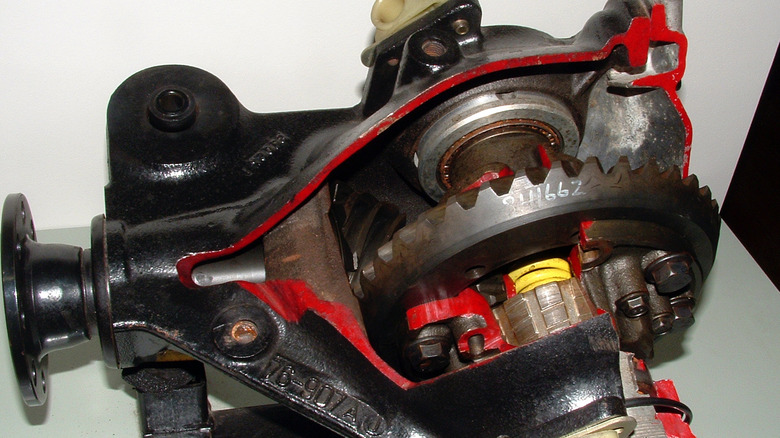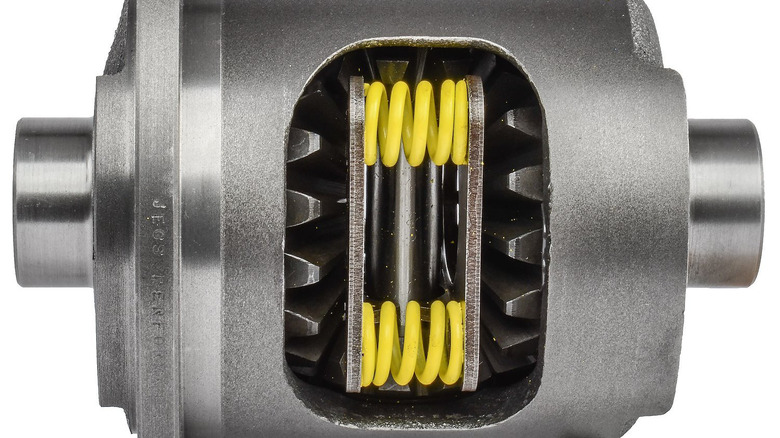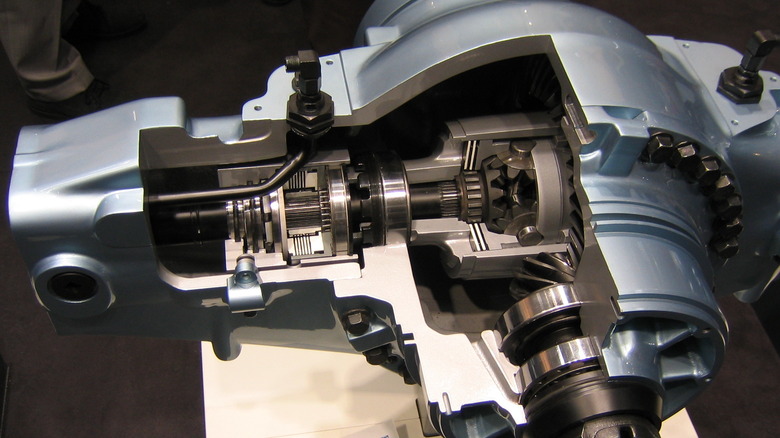What Is A Limited Slip Differential (LSD) And How Do They Work?
The realm of automotive technology is rife with jargon and acronyms, from ABS (Anti-Lock Brake System) — which first appeared in 1978 — to ZEV (Zero-Emissions Vehicles). Sitting squarely between those two alphabetic extremes in the glossary of automotive terms is LSD, which stands for Limited-Slip Differential. This feature is known by different names depending on the brand of vehicle it's in.
Chevrolet brands its stock limited-slip differentials as Positraction axles, Ford uses the Traction-Lok label, American Motors (AMC) referred to limited-slip differentials as Twin Grip axles, and many models in the Mopar family use the Sure Grip designation to note the presence of a limited-slip differential. On some Jeeps, the limited-slip differential is branded as Trac-Lok. LSDs are useful for off-roading and in high-powered muscle cars, but just what is a Limited-Slip Differential, how do they work, and do you need one?
[Featured image by RB30DE via Wikimedia Commons | Cropped and scaled | CC-By 3.0]
A limited-slip differential can prevent loss of traction
A differential is a set of gears in the middle of an axle that allows the wheels to turn at different speeds while the vehicle is cornering or riding on bumpy surfaces. With a standard, or open, differential, torque from the powertrain is sent primarily to the wheel with the least resistance. While open differentials are simpler than their limited-slip cousins, drivers can experience a loss of traction when one wheel is on snow, ice, or another slippery surface. Limited-slip differentials employ a mechanism to restrict the difference between the speeds at which each wheel can turn, ensuring that sufficient torque is provided to whichever wheel has a firmer grip on the road surface.
There are several different types of limited-slip differentials. Many use friction plates, or clutches, to distribute power to both wheels. Some LSDs use a stack of clutches known as a cone, while others have hydraulic fluid in between the clutches to create the friction necessary. Still others employ spur or worm gears, which are pressed against the inside of the differential housing to manage wheelspin. Some newer vehicles from Saab, General Motors, and Jeep use an electronic system, where various computers monitor wheel speeds and distribute torque to the one with the best grip. Many systems, like Mitsubishi's Active Center Differential, allow the driver to fine-tune the system's performance according to the driving surface.
How do I know if I have a limited-slip differential?
Limited-slip differentials are different from lockers, which also come in mechanical and electronic versions. Like the name implies, a locker binds the two wheels on an axle together, ensuring that they both turn at the same speed when the locker is engaged. There are simple tests you can do to see if you have a locker or limited-slip differential in your vehicle. To test for the presence of a limited-slip mechanism, chock the front wheels and jack up the rear of the vehicle with it in neutral and the parking brake off.
Rotate one of the rear wheels by hand. If the other wheel turns in the same direction, you have a limited-slip differential, and if the opposite wheel spins in the other direction your differential is open. It's important to know if you have an LSD in your car, as they require a special additive to be included when changing the differential's gear oil. Call your dealership's service department to identify the correct gear oil and LSD additive for your vehicle.
Limited-slip differentials are more complex than open diffs
To test for the presence of a locker, jack up the rear end but keep the vehicle in gear. Have an assistant rotate one wheel to the rear until it stops and hold it in position. Spin the opposite wheel in both directions. If you have a locker, you should hear a ratcheting sound from the differential when rotating the wheel forward, and you should be unable to rotate the wheel backwards. You can repeat the test by rotating one wheel forward to begin, and switch sides with your helper to complete the test in all four possible directions to confirm. The advantages of a locker or limited-slip differential are clear: better traction on slippery roads or off-road surfaces like sand, mud, and gravel.
LSDs are more complex than open differentials, though, requiring the aforementioned additive and costing more to produce. Off-road enthusiasts have an ongoing debate as to whether a locker or limited-slip differential is best, but performance-minded drivers clearly favor LSDs for track and on-road use. Chevrolet included a Positraction rear end in the impressive 1967 L88 Corvette, helping that model achieve a sub-seven second 0-60 time. You can purchase an aftermarket limited-slip differential to upgrade a vehicle with an open diff, but the installation can be complex and should probably be entrusted to a professional mechanic.
[Featured image by Aconcagua via Wikimedia Commons|Cropped and scaled|CC-By 3.0]


